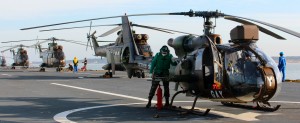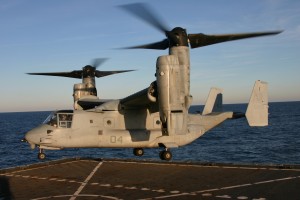by Robbin Laird
Recently, the USN-USMC team completed the largest “amphibious” exercise in more than a decade along with core allies. But what did people see? What did they recognize in the exercise and focus upon?
Because it is called an amphibious exercise, outsiders who attended the exercise tended to focus upon the amphibious ships themselves, the landing ships, the vehicles and the assault on the beach. This is the trouble with what one sees.
The reality was that this was a power projection exercise, it was a maneuver of forces from the sea inland and out again. Bold Alligator 2012 was a shift towards a new paradigm. With the U.S. and its allies turning from the land wars of the past decade to formulating new approaches for the decade ahead shaping new approaches to the use of joint and coalition forces is clearly required.
In an interview after the exercise, Admiral Kevin Scott, Commander of the 2nd Expeditionary Strike Group underscored that the core effort was to bring the USN-USMC and the coalition team together into an enhanced capability to operate from the sea. Re-crafting maneuver warfare from the sea is not just about technology and new capabilities; it is based on a con-ops where collaborative team efforts become seamless.
http://www.sldforum.com/2012/02/admiral-scott-on-the-core-question/
With global challenges not going away, and financial constraints biting in, the need to get best value out of current assets while adding new ones is a key element out of strategic change.

The seabase can provide new maneuver warfare from the sea capability, seen off of the shores of Tripoli and practiced then off of the shores of Virginia and North Carolina.
So what images of change were embedded in the Bold Alligator picture? There are more than can be discussed in a single article, but I will focus on my top 8 images of change.
First, an assault raid was conducted from the seabase deep inland (180 miles) aboard the Ospreys with allied forces observing or participating. The Osprey was the key element operating in this exercise, which was not there during the last big “amphibious” exercise.
As the key coalition officer (Lt. Commander Pastoor) in the planning process, a Dutch naval officer, underscored: “We had Dutch observers and they were very impressed with the game changing capabilities of the Osprey in terms of range and speed. Normally, in such an exercise we would take the beach and operate 30 miles inland. With this new capability we can operate throughout the entire battlespace and move forces as if across a chessboard.”
Let us hover over this image. Instead of assaulting the beach, the forces aboard the sea base are maneuvering within and over the battlespace inserting, moving and withdrawing forces. This is a far cry from just looking at photos of the landing ships and assault vehicles.
http://www.sldforum.com/2012/02/lt-commander-george-pastoor-on-the-core-question/
Second, one would have looked at the BAC1-11 aircraft carrying the F-35 combat systems and would see many things, notably the capacity to provide information to the MARSOC insertion forces about the battlespace in real time which would effectively guide them in enhancing operational success. The combat systems are tested and mated with the weapons certification of the F-35 this spring; we can do the Nike thing, just do it.
Third, if one had visited the exercise team prior to the exercise, one would have seen an incredible process of integration of coalition partners into the planning process. And a core focus of these planners has been upon sorting out to more effectively managing information, distributing information and operating with a common operational picture.
Returning to our coalition planner, Lt. Commander Pastoor:
Coalition is a key part of Bold Alligator. It’s been there from beginning. From the very first concept development conferences in the beginning a year ago, coalition engagement was central. Nowadays operations aren’t done without coalitions. The Bold Alligator process is U.S. and coalition as one team from beginning onwards. It’s really working well, getting to the same goals, doing the planning process together, working in close coordination with the French Task Group, having their plan’s over, having 6 to 10 officers from New Zealand flying in for planning conference. We have a lot of coalition participants in our staff for the operation itself really emphasizes the importance of coalition.
And he emphasized the managing information off of the SIPERNET was and is a problem. This is why the default for future operations will need to be CENTRIX or the NATO standard. During the exercise CENTRIX was used as the coin of the realm. Pastoor underscored that planning needs to be done in CENTRIX so that there is a seamless flow to exercise and operational collaboration.
https://sldinfo.com/bold-alligator-in-the-review-view-mirror-2nd-esg-reflects-on-lessons-learned/
Fourth, the French amphibious ship the Mistral was the centerpiece of a physical allied contribution. The ship and its team arrived early for bilateral operations with the USN-USMC team and the ship was cross-certified with US equipment and procedures. The ship was one of the stars of the Libyan operation and worked closely with the Allies in dealing with those challenges.
But the Mistral represents an entire class of ships of various sizes being built by allies – Spain, Italy, South Korea, Australia, etc. – that will carry significant aviation assets evolving over the years ahead and give this capability longer reach and impact. The sea base is evolving, not retracting in its lethality and impact on tactical and strategic operations. The F-35B will be added to several decks, the Opsrey, the Tiger and X-3 helicopters, the CH-53K, the NH-90, unmanned aerial vehicles of various sizes and kinds. In short, the future belongs to clusters of these types of ships.
Fifth, the Mistral image would raise another image. No platform fights alone. The Mistral deploys with other ships, notably frigates which provide for the air defense of the ship. And images could be seen if one looked of ships like the Aegis which engaged and deployed to provide a protective cover along with the Big E and its deployed assets.
Sixth, the images of the Harriers operating off of the Kearsarge raised another prospect of capabilities and changes. 16 Harriers operated off of the large deck amphibious ship, in an approach which was very un-ARG like. Normally, the USN-USMC team operates in three ship formations called Amphibious Ready Groups with a Marine Expeditionary Unit or MEU onboard. This exercise worked at a much more aggregated level with many more ships involved in operating to insert force.

The Harriers based on the USS Kersarge worked closely with land-based air to provide for a significant air combat capability to shape the battlespace. This model can be followed immediately in the Middle East with Arab Air Forces, the Israeli Air Force or Western Air Forces deployed temporarily on Arab soil. The point is that the organizer of the spear is on the sea-base, and this capability can be conjoined with the various air combat centers extant or being developed in the region.
https://sldinfo.com/bold-alligator-2012-and-the-middle-east/
Seventh, the MV-22 landed on a T-AKE ship. This means that the ability of this new aviation asset to connect the supply ships with the combat ships can potentially allow a much more efficient use of those combat ships. Supplies can be re-configured off of the combat ships to the supply ships and with the VM-22 have just in time delivery capabilities.
What this in turn means is that by building more of these new supply ships, the combat power of the fleet can be enhanced, and the USN-USMC team get its ship numbers up. This is not a substitute for adding new Amphibious ships to the fleet, it is not. But with the new approach and new con-ops the combat capabilities can become extended and more sustained. It is about sustainable maneuver warfare from the sea. And the new VM-22 T-AKE combination is a potential war winner.
https://sldinfo.com/re-thinking-the-role-of-supply-ships-in-maneuver-warfare-from-the-sea/
Eighth, one could focus on the various images of capabilities to deal with asymmetrical threats. A clear message from the past decade is that one needs to define, respond and anticipate asymmetrical threats. The images of various assets dealing with the counter-mine threat, whether they be French special forces or SEALS in the water, the Canadian counter mine vessel, the Riverine forces, or the mammal insertion from the virtual engagement of West Coast USN teams were prevalent and clear. A seabase will not survive if the assymetric threats are not accounted for and dealt with.
In short, re-shaping maneuver warfare from the sea by encompassing allied and US land-based air and other support and strike capabilities is a crucial element of the way ahead.
New uses of the sea base, new capabilities deployed from the sea base will allow the U.S. and its allies to deploy scalable forces and to shape a force appropriate to the mission. An economy of force approach can be shaped to ensure that mission and forces match, but with scalability other capabilities can augment the force to ensure mission success.
An earlier version of this piece appeared on AOL Defense
http://defense.aol.com/2012/03/21/bold-alligator-a-glimpse-of-marine-navy-future/
We have posted a special report on Bold Alligator 2012, which looks at the evolution of the Expeditionary Strike Group. We have as well posted a briefing which provides an overview to some of the topics discussed in the Special Report. The entry point to both can be found at this link:

